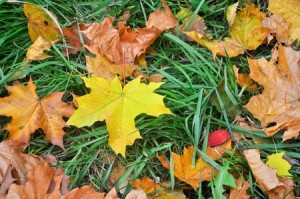It’s that time of year when the leaves start to change colour and fall from the trees. While the beautiful array of colours and the satisfying crunch of dried leaves beneath your feet is a sure sign that winter is just around the corner, these leaves are much more than a natural omen of the changing seasons. Leaves are an excellent source of nutrients for garden plants, and more importantly, your lawn.
Thank you for reading this post, don't forget to subscribe!

If you don’t have many trees or deciduous plants in your garden then you probably won’t have to do much leaf management apart from raking up the odd few. However, your neighbours may have more than they can deal with, so if you compost then try to take a few bags from them to add to your heap, or to mulch and use to protect and fertilise border plants through the winter. You could also rake up leaves from your local park for the same purpose.
Raking the leaves up is what most people do, as a thick carpet of leaves will not break down quickly and will prevent any sunlight getting to your lawn. The raked leaves can be added to a compost pile, or left to decompose on their own into leaf mould. These leaves should be shredded to speed up the process, and this can be done with a strimmer, a lawn mower or some leaf blowers that have a shredding option.
Leaf mould is high in calcium, magnesium and nitrogen so it makes an excellent fertiliser. It also retains a lot of water, making it even better than peat moss for feeding and protecting plants throughout the winter. There may be areas of your lawn that you want to kill (perhaps if there are a lot of weeds, or the wrong type of grass) and leaf mould piles are a good, natural way to do this. By preventing sunlight from reaching the grass you want to kill off they will die back naturally during the winter, and the decomposing leaves will help fertilise and prepare the underlying soil for replanting in the spring.
With advances in lawn mower technology, raking leaves from the lawn is not the only option any more, and lawn mowers with in-built mulching capabilities really come into their own for managing the leaf problem. If you intend to mulch leaves into your lawn, it is best not to wait for a very thick carpet to form, as it will take a lot longer to successfully shred them and means running the lawn mower over the same spots several times.
However, taking the time to shred the leaves finely and leave them on the lawn surface means the grass blades can still see the sun, allowing them to photosynthesise and make the most of the nutrients provided by the decomposing leaves and grass clippings.

If there is a thick carpet of leaves to mulch, it is better to rake a few up and shred them separately, then run the lawn mower over the remaining ones left on the lawn.
Some ride-on lawn mowers have collection attachments that will collect up leaves left on the lawn surface, which is a lot easier than raking especially if you have a large area to work on.
Of course, there are projects you can do with children than involve leaves; why not get them to collect the prettiest leaves they can find, then help them identify the species of tree they came from? These dried leaves can be strung together to create a seasonal garland, or preserved with glycerin for use in greetings cards and art projects. Simply immerse leaves in a glycerin solution (available from most pharmacies), weigh them down and leave for 3-5 days until the leaves are supple. Dry them out and hey presto – preserved leaves for Christmas cards and other seasonal projects.
